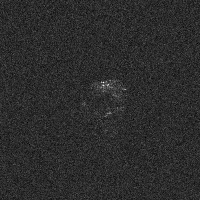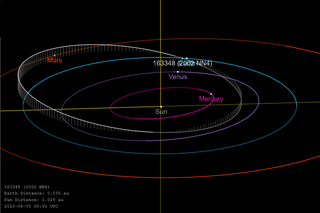Related Research Articles
(12538) 1998 OH is a stony asteroid, classified as near-Earth object and potentially hazardous asteroid of the Apollo group, approximately 1.8 kilometers in diameter. It was discovered on 19 July 1998, by astronomers of the Near-Earth Asteroid Tracking program at the Haleakala Observatory in Hawaii, United States. This minor planet was numbered by the Minor Planet Center on 23 November 1999. As of 2018, it has not been named. In 2019, the asteroid came within about 73 lunar distances of Earth.
4401 Aditi is an eccentric, stony asteroid, classified as a near-Earth object and Amor asteroid, approximately 1.8 kilometers in diameter. It was discovered on 14 October 1985 by American astronomer Carolyn Shoemaker at Palomar Observatory in California, and later named after the Hindu goddess Aditi.
26074 Carlwirtz is a dynamical Hungaria asteroid and binary Mars-crosser from the innermost regions of the asteroid belt, approximately 3 kilometers in diameter. It was discovered on 8 October 1977, by German astronomer Hans-Emil Schuster at ESO's La Silla Observatory in northern Chile. The likely binary asteroid on a relatively circular orbit has a short rotation period of 2.5 hours. It was named for German astronomer Carl Wilhelm Wirtz. The system's suspected minor-planet moon of unknown size was first detected in 2013.
6296 Cleveland, provisional designation 1988 NC, is a Hungaria asteroid from the innermost regions of the asteroid belt, approximately 3.5 kilometers in diameter. It was discovered on 12 July 1988, by American astronomer Eleanor Helin at the Palomar Observatory in California. The presumed E-type asteroid has a long rotation period of 30.8 hours and possibly an elongated shape. It was named for the city of Cleveland in the U.S. state of Ohio.
3800 Karayusuf, provisional designation 1984 AB, is a Mars-crossing asteroid and suspected binary system from inside the asteroid belt, approximately 2.5 kilometers in diameter. It was discovered on 4 January 1984, by American astronomer Eleanor Helin at the Palomar Observatory in California. The S/L-type asteroid has a short rotation period of 2.2 hours. It was named after Syrian physician Alford Karayusuf, a friend of the discoverer.
1355 Magoeba, provisional designation 1935 HE, is a Hungaria asteroid and a suspected contact-binary from the innermost regions of the asteroid belt, approximately 5 kilometers in diameter. It was discovered on 30 April 1935, by English-born, South African astronomer Cyril Jackson at the Johannesburg Observatory in South Africa. The asteroid is named for Magoeba, a tribal chief in the South African Transvaal Province.
3873 Roddy, provisional designation 1984 WB, is a stony Hungarian asteroid, Mars-crosser and suspected binary system, from the innermost regions of the asteroid belt, approximately 7 kilometers in diameter. It was discovered on 21 November 1984, by American astronomer Carolyn Shoemaker at the Palomar Observatory in California, United States. It was named after American astrogeologist David Roddy.
(6382) 1988 EL is a stony Hungaria asteroid from the inner regions of the asteroid belt, approximately 5 kilometers in diameter. It was discovered on 14 March 1988, by American astronomer Jeffrey Alu at the U.S. Palomar Observatory, California.
(467336) 2002 LT38, is a sub-kilometer asteroid and suspected tumbler, classified as a near-Earth object and potentially hazardous asteroid of the Aten group, approximately 240 meters (790 ft) in diameter. It was discovered on 12 June 2002, by astronomers of the Lincoln Near-Earth Asteroid Research at the Lincoln Laboratory's Experimental Test Site near Socorro, New Mexico, in the United States.
(416151) 2002 RQ25 is a carbonaceous asteroid of the Apollo group, classified as near-Earth object and potentially hazardous asteroid, approximately 0.2 kilometers in diameter. It was discovered on 3 September 2002, by the Campo Imperatore Near-Earth Object Survey (CINEOS) at the Italian Campo Imperatore Observatory, located in the Abruzzo region, east of Rome.
(374158) 2004 UL is a sub-kilometer asteroid on an outstandingly eccentric orbit, classified as near-Earth object and potentially hazardous asteroid of the Apollo group. The object is known for having the second-smallest perihelion of any known asteroid, after (137924) 2000 BD19.

(436724) 2011 UW158, provisionally known as 2011 UW158, is a stony, walnut-shaped asteroid and fast rotator, classified as near-Earth object and potentially hazardous asteroid of the Apollo group, approximately 300 meters in diameter. It was discovered on 25 October 2011, by Pan-STARRS at Haleakala Observatory on the island of Maui, Hawaii, in the United States.
20936 Nemrut Dagi is a stony Hungaria asteroid and Mars-grazer from the innermost regions of the asteroid belt, approximately 3.5 kilometers in diameter. It was discovered on 13 May 1971, by Dutch astronomer couple Ingrid and Cornelis van Houten at Leiden, on photographic plates taken by Dutch–American astronomer Tom Gehrels at Palomar Observatory in California, United States. The asteroid has a rotation period of 3.28 hours, a likely spheroidal shape, and a high albedo typically seen among the enstatite-rich E-type asteroids. In 2012, it was named after the a dormant volcano Nemrut in Turkey.

(190166) 2005 UP156 is a stony asteroid and binary system, classified as near-Earth object of the Apollo group, approximately 1 kilometer in diameter. It was discovered on 31 October 2005, by astronomers of the Spacewatch survey at the Kitt Peak National Observatory in Arizona, United States. Its minor-planet moon with an orbital period of 40.25 hours was discovered in 2017.
(159857) 2004 LJ1, provisional designation 2004 LJ1, is an asteroid on an eccentric orbit, classified as near-Earth object and potentially hazardous asteroid of the Apollo group, approximately 3 kilometers in diameter. The asteroid was discovered on 10 June 2004, by astronomers of the LINEAR program at Lincoln Laboratory's Experimental Test Site near Socorro, New Mexico, in the United States. It is one of the largest potentially hazardous asteroids known to exist.
(85713) 1998 SS49 (provisional designation 1998 SS49) is an asteroid on an eccentric orbit, classified as near-Earth object and potentially hazardous asteroid of the Apollo group, approximately 3 kilometers (1.9 miles) in diameter. The asteroid was discovered on 29 September 1998, by astronomers of the LINEAR program at Lincoln Laboratory's Experimental Test Site near Socorro, New Mexico, in the United States. It is one of the largest potentially hazardous asteroids and has a notably low Earth-MOID of less than the distance to the Moon.
(385343) 2002 LV, provisional designation 2002 LV, is a stony asteroid on a highly eccentric orbit, classified as near-Earth object and potentially hazardous asteroid of the Apollo group, approximately 1.5 kilometers in diameter. It was discovered on 1 June 2002, by astronomers with the Lincoln Near-Earth Asteroid Research at the Lincoln Laboratory's Experimental Test Site near Socorro, New Mexico, in the United States. The Sr-type asteroid has a rotation period of 6.2 hours and is likely elongated.
(15502) 1999 NV27 (provisional designation 1999 NV27) is a Jupiter trojan from the Trojan camp, approximately 53 kilometers (33 miles) in diameter. It was discovered on 14 July 1999, by astronomers with the Lincoln Near-Earth Asteroid Research at the Lincoln Lab's ETS near Socorro, New Mexico, in the United States. The dark Jovian asteroid has a rotation period of 15.1 hours and belongs to the 90 largest Jupiter trojans. It has not been named since its numbering in June 2000.
(172034) 2001 WR1, provisional designation: 2001 WR1, is a sub-kilometer near-Earth object of the Amor group, approximately 650 meters (2,100 feet) in diameter. The S-type asteroid has been identified as a potential flyby target of the Hayabusa2 mission. It was discovered on 17 November 2001, by astronomers with the Lincoln Near-Earth Asteroid Research at the Lincoln Laboratory's Experimental Test Site near Socorro, New Mexico, in the United States. The asteroid has a rotation period of 8.0 hours and possibly an elongated shape. It remains unnamed since its numbering in December 2007.

(163348) 2002 NN4 (prov. designation:2002 NN4) is a dark, sub-kilometer near-Earth object and potentially hazardous asteroid of the Aten group that flew by Earth on 6 June 2020. The highly elongated X-type asteroid has a rotation period of 14.5 hours and measures approximately 0.7 kilometers (0.4 miles) in diameter. It was discovered by LINEAR at the Lincoln Laboratory's Experimental Test Site in New Mexico on 9 July 2002.
References
- 1 2 3 4 5 6 7 8 "JPL Small-Body Database Browser: 90075 (2002 VU94)" (2017-12-22 last obs.). Jet Propulsion Laboratory . Retrieved 18 January 2018.
- 1 2 3 4 5 "90075 (2002 VU94)". Minor Planet Center. Retrieved 18 January 2018.
- 1 2 3 4 Nugent, C. R.; Mainzer, A.; Masiero, J.; Bauer, J.; Cutri, R. M.; Grav, T.; et al. (December 2015). "NEOWISE Reactivation Mission Year One: Preliminary Asteroid Diameters and Albedos". The Astrophysical Journal. 814 (2): 13. arXiv: 1509.02522 . Bibcode:2015ApJ...814..117N. doi:10.1088/0004-637X/814/2/117 . Retrieved 18 January 2018.
- 1 2 3 4 5 6 7 8 "LCDB Data for (90075)". Asteroid Lightcurve Database (LCDB). Retrieved 18 January 2018.
- 1 2 Warner, Brian D. (July 2017). "Near-Earth Asteroid Lightcurve Analysis at CS3-Palmer Divide Station: 2016 December thru 2017 April". The Minor Planet Bulletin. 44 (3): 223–237. Bibcode:2017MPBu...44..223W. ISSN 1052-8091 . Retrieved 18 January 2018.
- 1 2 Warner, Brian D. (January 2015). "Near-Earth Asteroid Lightcurve Analysis at CS3-Palmer Divide Station: 2014 June-October". The Minor Planet Bulletin. 42 (1): 41–53. Bibcode:2015MPBu...42...41W. ISSN 1052-8091 . Retrieved 18 January 2018.
- 1 2 Warner, Brian D. (April 2015). "Near-Earth Asteroid Lightcurve Analysis at CS3-Palmer Divide Station: 2014 October-December". The Minor Planet Bulletin. 42 (2): 115–127. Bibcode:2015MPBu...42..115W. ISSN 1052-8091 . Retrieved 18 January 2018.
- 1 2 "List of the Potentially Hazardous Asteroids (PHAs)". Minor Planet Center. Retrieved 18 January 2018.
- ↑ "MPC/MPO/MPS Archive". Minor Planet Center. Retrieved 24 February 2018.